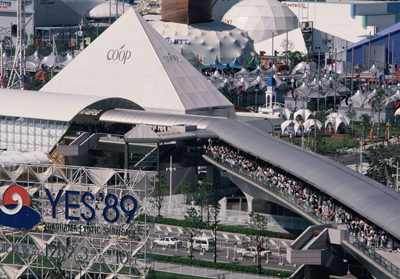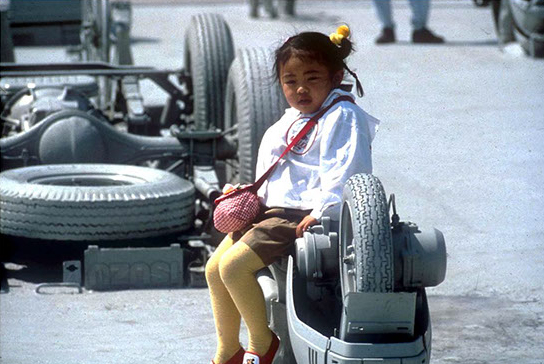During the Bubble Era, with Japan’s economy flush with cash, a number of regional expos sprang up around the country. Akin to miniature world’s fairs, they showcased local culture and industry thanks to corporate sponsors bursting with coin. One such company was Isuzu Motors, who sponsored the 1989 Yokohama Expo with a strange interactive art exhibit and futuristic buses.

The expo was held at what is today the Minato Mirai port area of Yokohama, and it was no small affair. It was held for 191 days, from March to October of 1989 and attracted over 13.3 million visitors. No private cars were allowed in the venue and parking was extremely limited, so ads for the event encouraged attendees to use buses, trains, and ferries to get there.
A number of transportation systems were built especially for the expo, including a gondola, a moving walkway, and Japan’s first maglev train sponsored by Mitsukoshi Department Store. As the automotive sponsor, Isuzu contributed an army of regular buses, but also created their own futuristic buses specifically for the event.
Both had their wheels tucked way under the bodywork to give the illusion that they were floating. The Isuzu Jumbo Cruiser featured an enclosed compartment in front and an open observatory deck at the rear. It resembled a hovercraft and could carry 40 people. It was used to move spectators on a set route of about 1.5km around the park. Some accounts say that Isuzu built a total of four of them in various colors.
However, one futuristic bus simply wasn’t enough. So Isuzu also built a second futuristic shuttle, called simply the Isuzu Bi-Directional Bus. As the name implied, it was symmetrical at its lengthwise midpoint, could drive in either direction, and had a driver’s seat on either end. Its sole purpose was to go back and forth between the Sea Gate and the Gondola Gate, a distance of just 0.25 miles. Total capacity rang in at 29 people, and Isuzu built just one example.
Isuzu’s participation wasn’t limited to buses. They also created a bizarre exhibit that featured a bunch of upside-down cars, trucks, and human legs resembling a nightmarish teleportation accident. The field of fiberglass sculptures was located outside one of the main train stations leading to the expo and was, oddly enough, a playground meant to inspire children.
The installment was created by art and architecture firm SITE New York, founded by James Wines. It’s the same organization that created the Ghost Parking Lot in Hamden, Connecticut and Highway ’86 at the Canada World Expo (JNCers may notice some familiar machinery in the latter). The creators describes it thusly:
Isuzu Motors and Japan Railway sponsored this children’s plaza in front of the Yokohama’s Sakuragicho Train Station. The project was commissioned to celebrate the links between people, ground transportation and space exploration. Since venturing into the cosmos is closely associated with an absence of gravity, the plaza plane supports an inverted world of people and Isuzu vehicles. To achieve this effect, the lower bodies and legs of a large number of Yokohama residents have been cast from life in fiberglass, then installed in a reversed position. The intention is to create the illusion of an invisible walking surface, suspended above the actual plaza level. In order to enhance this surreal dimension, all of the human figures, automobiles, bicycles, street furniture and tree roots are monochrome gray to match the color of the paving.
Surprisingly, these days there is precious little about Isuzu’s participation in the Yokohama Expo. Only a few old photos of the exhibit and buses exist online. Some of the attractions built for the expo, however, remain to this day including the Yokohama Museum of Art, Yokohama Port Museum, and the Cosmo Clock 21 ferris wheel, the tallest in the world at the time it was built. These remnants serve as a stark reminder of how quickly things in Japan can be built, torn down, and forgotten.
Images: SITE – James Wines, LLC, Yokohama City Archives, Wikimedia Commons, Minato Mirai 21.











